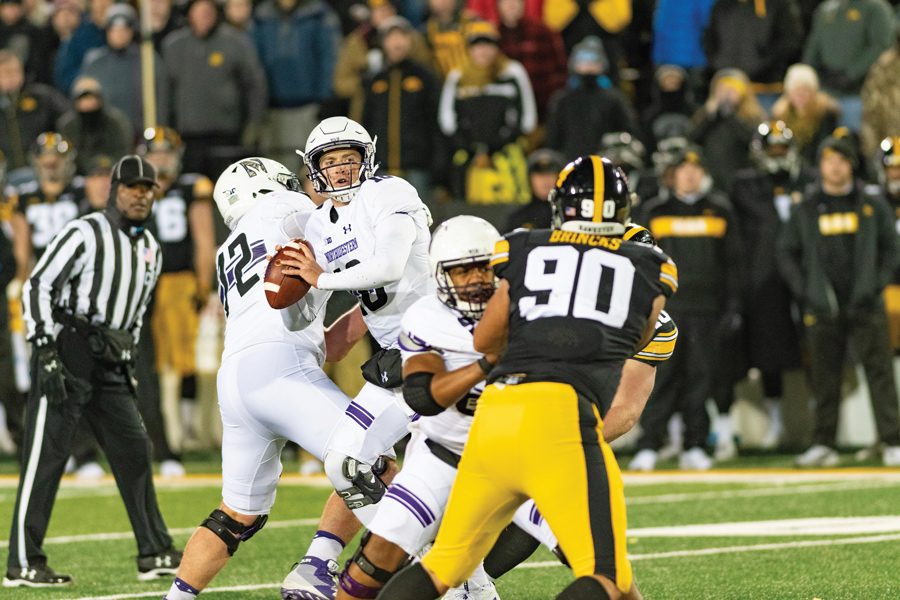Football: Examining the statistical quirks of Clayton Thorson’s season
Daily file photo by Noah Frick-Alofs
Clayton Thorson surveys the field against Iowa. The senior quarterback has had wildly divergent performances this season.
November 15, 2018
Football
At times this season, Clayton Thorson has been outstanding. At other times, Northwestern’s senior quarterback has been almost miserable. But never has he been average. The senior quarterback has yet to finish a game this season with between 200 and 350 passing yards.
He is averaging 233 yards per game, but has never come within 30 yards of that number.
For comparison, in 2016, Thorson had eight games in that range, and in 2017, he had four. Gardner Minshew, the Washington State signal-caller who leads the country in passing yards in 2018, has five. Even Art Sitkowski, who quarterbacks Rutgers’ conference-worst passing offense, has three games in this range.
And Thorson has only been close only once, when he threw for 198 yards against Duke. In the other nine games, he hasn’t even come within 20 yards of either endpoint. He attributed the variation to gameplan changes.
“Different games call for different things, and that’s what’s happened,” Thorson said this week. “I’ll take wins any way we can get them.”
As Thorson suggests, there are ways to explain this oddity. In the Wildcats’ first two games, against Purdue and Duke, Thorson was still splitting time with backup junior T.J. Green and likely would have finished with more than 200 yards had he been healthy enough to play every snap. However, this timeshare didn’t stop him from throwing for a then-career-high 383 yards in the next game against Akron.
The three games in which the senior has thrown for more than 350 yards (Akron, Michigan State and Nebraska) are also the three games in which he has attempted the most passes. In some of his games with fewer than 200 yards, such as last Saturday’s win over Iowa, NU has run the ball more than 45 times.
“It really depends on how the game is going,” Green said Tuesday. “Last week, we were running the ball so effectively that we didn’t have to rely on the pass game as much. Other games, we can’t run the ball as well, and he’s airing it out.”
In his past four games, Thorson’s numbers have been unimpressive. This could be attributed to the caliber of passing defenses he’s been up against. Apart from the Rutgers game, which Thorson admitted was his worst of the season, he has faced three top-55 passing defenses by S&P+ and thrown for fewer than 200 yards each time.
To Thorson and Green’s points, NU ran the ball effectively in victories against both Wisconsin and Iowa, totalling more than 180 yards on the ground in each contest. Those numbers were a far cry from the wins over Michigan State and Nebraska, in which the Cats ran for 40 net yards in two games.
Saturday’s opponent, Minnesota, boasts the 34th-best pass defense according to the holistic metric S&P+. That’s better than both Wisconsin (55th) and Iowa (37th), but worse than Michigan State (23rd). They’ve also allowed between 200 and 350 passing yards six times in 10 games this season, a signal that Thorson could finally break his odd streak on what is expected to be a chilly day in Minneapolis.
“This is a really good team, they just beat up on Purdue,” Thorson said. “We know that they played well last week in the cold, so (we just have to) focus on our job and take it one play at a time.”
Whether or not Thorson is hitting arbitrary statistical boundaries, there is little doubt that NU has struggled to pass the ball this season. The Cats rank 84th in Passing S&P+, ahead of only Illinois among teams in the Big Ten west, which NU has already clinched.
As for coach Pat Fitzgerald, the Cats’ leader who is notoriously uninterested in particular statistics?
“Stats are for losers,” Fitzgerald said. “We won, right?”
Email: [email protected]
Twitter: @joe_f_wilkinson


